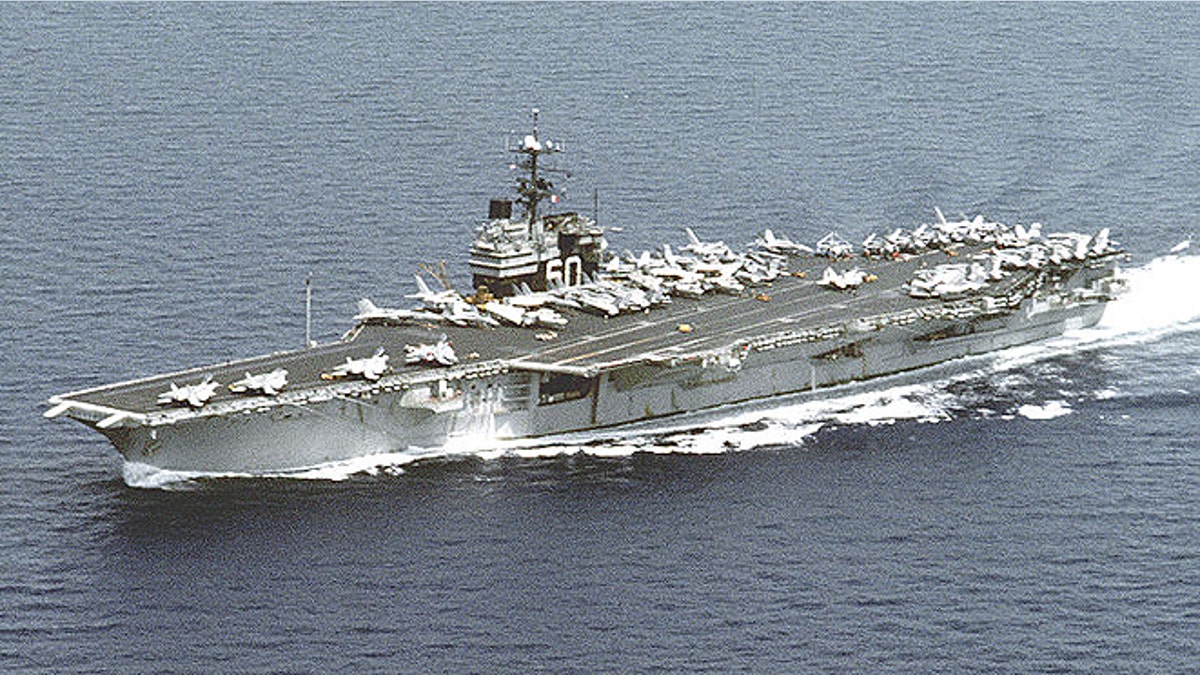
The ship, seen here in 1992, is currently berthed at the Naval Station Newport in Rhode Island and will depart for Texas later this summer. (Department of Defense)
The USS Saratoga — the legendary aircraft carrier that played a key role in the Cuban Missile Crisis, Vietnam and Gulf wars and made Libyan strongman Muammar Qaddafi back down — is destined for dismantling after the Navy paid one penny to a Texas firm to recycle the 81,101-ton behemoth.
The once-mighty vessel is the second of three conventionally-powered carriers to set to sail to the scrapyard, following another one-cent deal involving the USS Forrestal in October. ESCO Marine, of Brownsville, will pay to tow, dismantle and recycle the ship, which was decommissioned in 1994 after more than 38 years of service. Efforts to spare the ship failed, as they did with the Forrestal last year.
“[It is] emotional in that we who served on ‘Sara’ feel that our ‘surrogate mother’ is passing from our lives,” Sammy King, secretary of the USS Saratoga Association, told FoxNews.com in an email. “We owe her a lot. We went aboard as ‘snot-nosed kids’ and left as ‘men.’ Some of us are very sad and some are very angry at the decision to scrap her.”
[pullquote]
King, who served on the carrier from 1961 to 1962, said his organization raised several millions of dollars in the hope that the ship would eventually become a museum, much like the USS Midway, which opened as a naval aviation museum in San Diego in 2004. But the effort was defeated by "bureaucratic obstacles," he said.
The ship, currently berthed at the Naval Station Newport in Rhode Island, will depart for Texas later this summer. It was available for donation to a state or nonprofit organization for public display as a museum or memorial for 12 years, but no viable applications were received. The price reflects the net price proposed by the company, Naval officials said.
“The Navy continues to own the ship during the dismantling process,” Naval Sea Systems Command officials said in a news release. “The contractor takes ownership of the scrap metal as it is produced and sells the scrap to offset its costs of operations.”
The carrier, the sixth Saratoga in U.S. history, was the second carrier built after World War II. She was constructed at the New York Naval Shipyard of Brooklyn and was officially commissioned in 1956. Throughout its four decades of service, more than 60,000 sailors served on its decks, with roughly 5,000 at any given time. In addition to its pivotal role in the 1962 Cuban Missile Crisis, the USS Saratoga saw duty in the Gulf of Tonkin during the Vietnam War and launched the first strikes of the Gulf War against Iraq.
The massive carrier — as long as the Empire State Building is tall — also saw its share of atypical operations. In 1985, during a routine deployment in the Mediterranean, the Saratoga launched seven F-14 Tomcats to force a jet carrying terrorists who had just hijacked the Achille Lauro cruise ship, killing an American, to land. A year later, the ship was sailing off the Libyan coast in the Gulf of Sidra when it crossed what Libyan leader Col. Muammar Qaddafi had called the "Line of Death." When three more U.S. Navy warships crossed the same navigational line, Libyan forces fired surface-to-air missiles at U.S. jets. The missiles missed, and U.S. jets later turned back two Soviet-made Libyan fighter planes sent toward the ships.
Five years later, 21 crew members who served aboard the carrier were killed when a ferryboat they were traveling on sank while returning from Haifa, Israel. And in 1992, USS Saratoga crew members mistakenly fired into a Turkish ship during NATO exercises, killing five Turkish sailors.
“At times when I stand on the pier and look up at this grand old lady there is an almost lifelike sense about her,'' said Capt. William H. Kennedy, the Saratoga's final commanding officer, told The Associated Press in 1994. ''Sort of a proud warrior who has come home to retire, knowing full well, 'We did it. Mission accomplished.'''





















